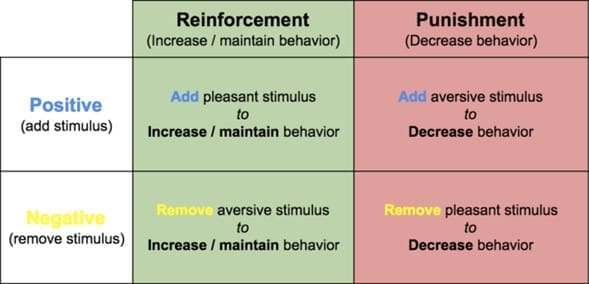In this post
A learning theory is applied in many areas of psychology; it explains that behaviour occurs as a result of the experiences that people have had throughout their lifetime and this applies to criminal behaviour just as it does to any other kind.
This section looks at criminal behaviour as a result of being rewarded, or from mimicking the actions of others who are displaying the same kinds of behaviour.
Operant conditioning as an explanation of criminality
BF Skinner, in the 1940s, developed the theory of operant conditioning arguing that the behaviours that someone exhibits will be repeated if they are reinforced or extinguished (not repeated again) if they are punished.
Within operant conditioning, there are two kinds of reinforcement, which are positive and negative, which will determine whether or not a kind of behaviour continues or stops. These can be difficult to grasp at first so make sure you understand the concepts which follow before moving on.
- Positive reinforcement: this occurs when someone receives a reward for the behaviour that they display. This means that the person is likely to repeat the behaviour again. So with criminal behaviour, for example, if someone gets a thrill from shoplifting, as well as being able to sell on the goods they steal and make money, they will almost certainly commit the same crime again
- Negative reinforcement: this occurs when a behaviour displayed is strengthened by avoiding an unpleasant experience. Getting rid of the unpleasant experience means someone is likely to repeat the behaviour again. For example, if a drug dealer is able to avoid competition in a local area by beating up another drug dealer and thus getting rid of them (as they are the unpleasant experience) then they will repeat this behaviour again
Operant conditioning also explains that punishment will have consequences on behaviour in that someone is less likely to repeat the behaviour again. Like with reinforcement, there are two kinds of punishment:
- Positive punishment: this occurs when there is a negative consequence for certain behaviours. Therefore, someone who is sent to prison for criminal behaviour, is less likely to repeat that behaviour, as they are being positively punished
- Negative punishment: this occurs when something that is pleasant is taken away from the individual as a result of undesirable behaviour. In criminal gangs, individuals are often removed from them if they refuse to take part in certain activities; the removal of them from the gang is negative punishment as they are being punished for not wanting to take part

The final part of operant condition, which you will need to know about, concerns reinforcers, which are used as a consequence for behaviour to strengthen certain types of behaviour:
- Primary reinforcers: these must satisfy one of a person’s basic needs, such as that for food or shelter. Children are often rewarded with food treats for good behaviour and this is an example of learning through primary reinforcers. People who commit crimes for money (such as burglary) because they live in poverty may behave in this way due to their desire to satisfy a basic need
- Secondary reinforcers: these types of reinforcements have no value in terms of someone not surviving if they do not have them but they are associated with primary reinforcers. For example, someone in a criminal gang may be praised by the gang leader and given a car as a reward for their part in criminal activity. The car is not a primary reinforcer but it leads to status within the gang and has a high monetary value, meaning that it could be sold for money and therefore used to buy goods to satisfy basic needs, such as food and drink
Activity – Damian and petty crime
Damian is 16 years old. He has found that on his way home in an evening after being out with his friends, he can try to open several car doors and find, when they are not locked, that he can easily steal the contents of a person’s car, if they have left things out on the seats. He has stolen money, jewellery, sunglasses and even a laptop. Some of the things he has kept and some he has sold on. His friends are really impressed by his new things and this encourages Damian to continue his criminal behaviour.
How could you explain Damian’s behaviour in terms of operant conditioning?
Strengths and weaknesses of operant conditioning
- A strength of this theory is that it is applicable to a large variety of different crimes and it explains very well how social approval can be a vital reinforcer in peer groups
- Another strength is that operant conditioning can also explain how punishment works in removing undesirable behaviours, as this is how procedures work in the criminal justice system in the UK
- Some behaviour management systems, such as token economies (which we will look at later in this unit), are based on the theories of operant conditioning
- A weakness of the theory is that not all crimes are committed due to reinforcement or punishment because criminal behaviour is thought to be far more complex than this, including other factors such as personality and genetic inheritance
- Finally, another weakness of the theory is that behaviour is often reproduced when there has been no reinforcement or punishment – people may resort to criminal behaviour because of other reasons, such as revenge. The theory cannot account for this type of criminal motivation



